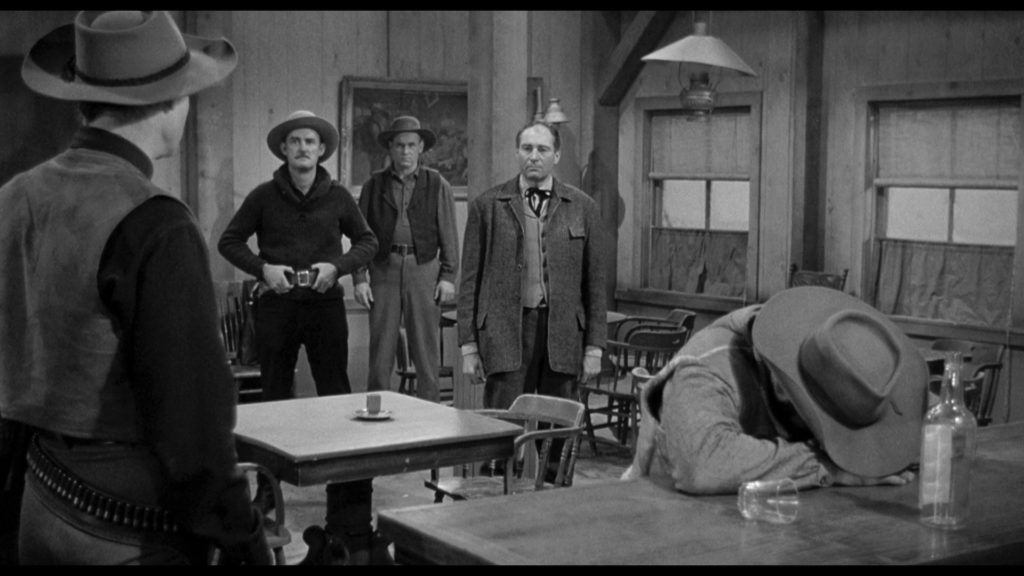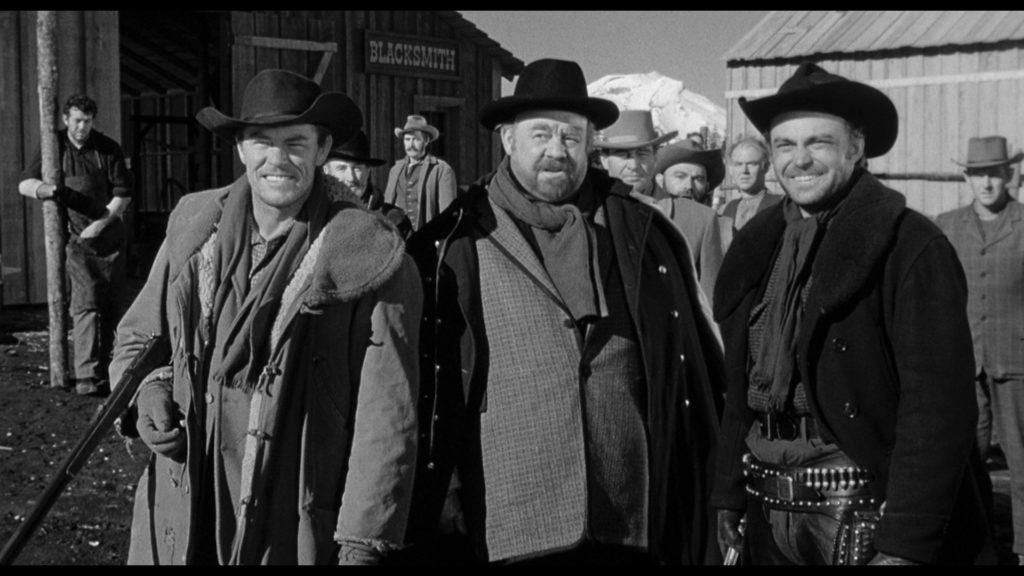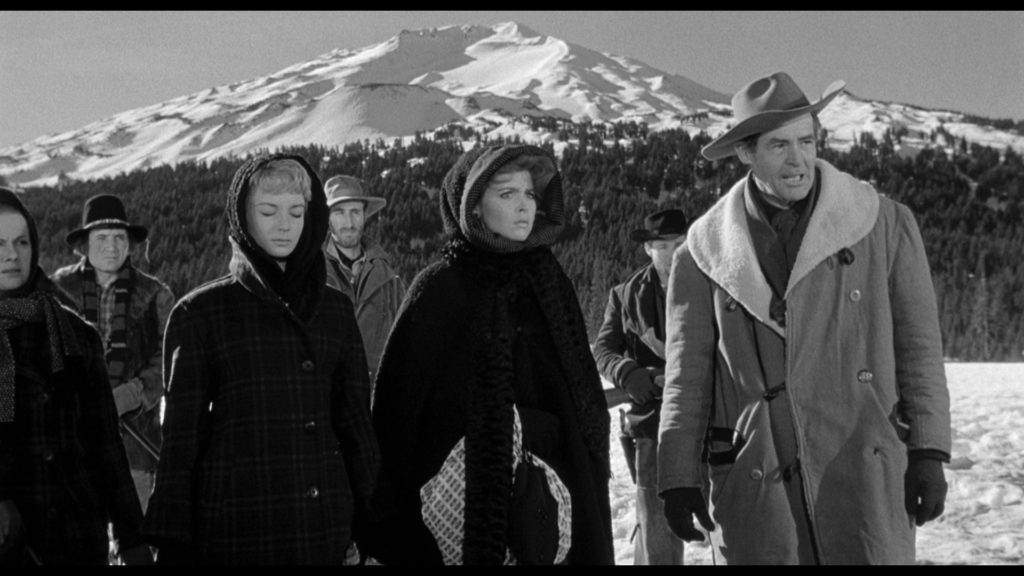Robert Ryan And Burl Ives Face Off In Stark, Snowy Northwestern
1959/DIRECTED BY ANDRÉ DE TOTH
STREET DATE: AUGUST 27TH, 2019/KINO LORBER STUDIO CLASSICS

Day of the Outlaw, released in 1959, impresses first with the harsh natural design of its setting as captured in the steely-gray tones of its black-and-white photography. Shot in Central Oregon during the cold and bitter late November – December of 1958, the jagged range of snow-topped Rocky Mountains overlooking the fragile cluster of wood-framed buildings dominates with an extraterrestrial beauty belying a community’s ability to survive in their landscape-extending shadows. Set in post-Civil War Bitters, Wyoming, the stark, snowy background imparts a bleak, wintry atmosphere to this Northwestern drama of violent conflict, shifting loyalties, and quick reversals. This prime exemplar of the era’s Noir Western marks the dark style of its telling with the high stakes of its drama for an hour-and-a-half’s worth of edge of one’s seat discomfort.

Opening on a pair of grizzled cow hands riding back to town over the hard-frozen trail, our first sight of Bitters, Wyoming is as starkly desolate as it is eerily forbidding. A community literally snow-carved out of the wilderness, with the sub-zero drift of the deepening season cutting off the huddle of wind-blown dwellings from civilization, the terms of survival exacted upon its citizenry equal the hard associations conjured up by it name. With towering white mountains jutting towards a black sky in the far distance, the cow hands’ conversation about local discord — the ever-Western conflict between ranchers and farmers — similarly reveals the monochrome view of personal passion and self-interest overtaking a remote town’s failing potential to self-sustain.
As further revealed by rancher and pioneer Blaise Starrett (Robert Ryan), hard off the winter round-up with taciturn riding partner Dan (Nehemiah Persoff), the miles of barbed wire recently erected by homesteader Hal Crane (Alan Marshal) has starved out a fair portion of his cattle, and the pun-intended bitter rivalry between the two has now reached its crisis point. Complicating the deepening situation, Starrett has been romantically involved with Crane’s wife Helen (Tina Louise), and upon arrival back at the town’s central saloon/hotel/trading post, Starrett is told by Helen that she intends to break off their affair. Descending the stairs of the hotel to confront Crane soon after, Starrett and Crane’s mutually homicidal intention clear, a gang of armed strangers suddenly bursts through the saloon entrance to hold the entire assembly at gunpoint.
Led by disgraced U.S. cavalry captain Jack Bruhn (Burl Ives), whom we later learn once ordered the massacre of a recalcitrant opposition of Utah Mormons, the gang is on the run from a robbery, laden with heavy sacks of gold, and are now trapped by the impassable mountains sky-lining the frigid distance. Having successfully eluded their pursuers, however, Bruhn, shot near his heart in execution of his crime, intends to hole up in Bitters until he and his vicious five-man gang can start again on the trail. Showing he means business, Bruhn immediately orders the shooting death of one of Crane’s party (possibly an innocent bystander) and thus begins a chess-like mortal match between Starrett’s shifty maneuverings to save the town and its people, Bruhn’s slipping ability to control his men as he slowly dies, and the unseen though omnipresent agency of chaos on the increasingly violent terms of wilderness survival.
Kino Lorber’s Blu-ray reproduces United Artists’ original poster as their cover image for this home video release, which features a scantily-clad woman (who I believe is co-star Tina Louise; later famed for her role as Ginger on TV’s Gilligan’s Island) crouched in a defensive position while holding a gun on two jack-booted thugs, framing the cheesecake image in waist-down silhouette. (The mountain range behind, over an abstract nether space the figures appear to be floating over, adds an effective if entertainingly nonsensical touch.) Visually hyperbolic, and certainly salacious, the graphic tagline “A Day You’ll Never Forget!” nevertheless captures Day of the Outlaw’s escalating dramatic stakes, which is expressed throughout its 92-minute running-time in an unusually frank and adult storyline; climaxing with an astonishing, unforgettable “dance” sequence — between the outlaws and townswomen — which plays like the grossest choreographed parody imaginable contemporary to the glossiest MGM musicals of yore.
Screenwriter Philip Yordan (Johnny Guitar [1954]) and director André De Toth (The Indian Fighter [1955]) craft a tension-filled atmosphere that sustains a keenly felt unpredictability in story, style, and character. Resonant with a vision of the West that would find its ultimate expression 26 years later in Cormac McCarthy’s 1985 novel Blood Meridian or the Evening Redness of the West, the daylight whiteness of the Pacific Northwest similarly evokes the trapped, frozen and hopeless position of both the townspeople and their captors — Bruhn’s gang — with mutually-assured destruction their only possible outcome.


Facing off in this starkly dramatic situation, Robert Ryan as the conflicted Starrett and Burl Ives as the dying Bruhn individually struggle against their allies and enemies alike until these story-framed antagonists are virtually indistinguishable by film’s end. Barely restraining the violent and predatory Tex (Jack Lambert) and Pace (Lance Fuller) from killing all the men in town and raping the women, Bruhn on his end feeds morphine down his spine to keep a wracking cough from ripping apart his insides. Similarly, Starrett uses all his considerable wiles, taking numerous physical and psychological beatings in the process, to sacrifice his own well-being on behalf of townspeople he had been on the verge of deadly confrontation with the day before.
As two actors of the era singularly able to suggest varying levels of screen “ambivalence”, not afraid to lose an audience’s sympathy, while in fact gaining the darker side of recognition and even identification, Ryan with his anguished levels of barely-concealed rage and Ives with his ramrod projection of patrician authority come to a precise point of screen superimposition at the film’s climax, as the former leads the latter and his gang into snow-peaked oblivion. With mutual, unspoken foreknowledge of the path’s impassability, Russell Harlan’s extraordinary black-and-white photography makes the sequence the most visually beautiful in the film even as the inhospitable environment successively claims a domino-fall of deserving and not-so-deserving victims.
It is no spoiler to say, one hopes, that Ives’s Bruhn — a genocidal murderer and thieving gangleader — dies a hero while Ryan’s Starrett — an embittered loner and community outcast — sincerely mourns him. Cliché that it may have become in later Westerns, the considerable strength of Day of the Outlaw derives from the story-merging sympathy of hero and villain: the outlaws’ day, one might say, has been hard-won on both ends.
In addition to the best-available home video presentation of Day of the Outlaw, with the high-contrast photography of its on-location exteriors beautifully evident in high definition, Jeremy Arnold’s commentary on the Kino Lorber Blu-ray comes jam-packed with production details, actors’ biographies, strong research, and deep analysis. Brutally uncompromising and starkly atmospheric, Day of the Outlaw deepens and darkens in story, theme, and character from the Western entertainments of old to the revisionist Westerns soon to follow. Holding a film-mirror up to unforgiving nature, the unlikely alignment of Western heroes and villains proves the final refuge of a community’s survival, and by extension a new pathway through old genre tropes: even when its logical endpoint implies the death of the genre itself.
The images from this review are credited to DVDBeaver and are captured directly from the Blu-ray. Thanks to Kino Lorber for providing a review copy.

